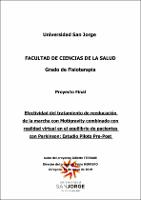Por favor, use este identificador para citar o enlazar este ítem:
https://repositorio.usj.es/handle/123456789/183
Registro completo de metadatos
| Campo DC | Valor | Lengua/Idioma |
|---|---|---|
| dc.contributor.advisor | Herrero Gállego, Pablo | - |
| dc.contributor.author | Terrade, Juliette | - |
| dc.date.accessioned | 2019-07-17T11:07:24Z | - |
| dc.date.available | 2019-07-17T11:07:24Z | - |
| dc.date.issued | 2019 | - |
| dc.date.submitted | 2019-05-17 | - |
| dc.identifier.uri | https://repositorio.usj.es/handle/123456789/183 | - |
| dc.description | Introduction: With Dementia, the Parkinson’s disease is the most frequent neurological disease striking the Elderly. Rehabilitation treatments aim to improve motor skills, autonomy and quality of life, allowing to decrease both direct and indirect costs derived from Parkinson’s disease. Aim: The purpose of this study is to analyze the Motigravity effectiveness, a Virtual Reality System combined with antigravity treadmill rehabilitation, for the improvement of balance concerning Parkinson patients. Material and methods: The treatment was applied in one group. Consisted in 12 sessions of 30 minutes of walking in the Motigravity body’s suspending platform with the virtual reality mask, 3 times a week, during 4 weeks. The balance measure was done with Tinetti Scale during the first and second weeks to see if there would be any clinical evolution without intervention on the patients. At the end of the intervention, Tinetti scale was done again to evaluate the evolution after this intervention. The significant value is p<0.05. Results: The sample was composed of 12 patients with PD. Data were analyzed with SPSS Statistics Software. A significative change was observed in the static balance (p=0,043) and total balance (p = 0,020). A significative improvement is shown in static (+0.75 point) and total (+1point) balance either. These changes were not clinically significant. Conclusion: Our findings indicated that Motigravity treatment combined with the virtual reality did not achieve statistically significant changes for the balance of the study’s participant. However, there is no clinical significative difference. | es_ES |
| dc.description.abstract | Introducción: Con la demencia, la enfermedad de Parkinson (EP) es la patología neurológica más frecuente en la edad avanzada. Los programas de rehabilitación tienen el objetivo de mejorar las habilidades motoras, la autonomía y la calidad de vida permitiendo disminuir los costes directos e indirectos derivados de la EP. Objetivo: El objetivo de este estudio es analizar la efectividad del Motigravity, un sistema de realidad virtual combinado a un programa de rehabilitación en cinta rodante antigravedad, para la mejora del equilibrio en paciente con EP. Metodología: Se aplicaba el tratamiento en un único grupo. Consistía en 12 sesiones de 30 min de marcha en la plataforma Motigravity en suspensión corporal con una mascara de realidad virtual, 3 veces por semana, durante 4 semanas. Se analizó el equilibrio con la escala de Tinetti en la primera semana y en la secunda en el fin de verificar la estabilidad clínica del paciente. Al final del periodo de intervención se analizó otra vez la escala de Tinetti en el objetivo de comparar con los valores previos a la intervención. Se consideraba como valor significativo p<0,05. Resultados: Se reclutó una población de 12 pacientes con EP. Se analizaron los datos con el software SPSS Statistics. Un cambio estadísticamente significativo se ha observado en el equilibrio estático (p=0,043) y en el equilibrio total (p=0,020). Se destaca una mejora significativa en el equilibrio total (+1punto), y estático (+0,75 punto). Dichos cambios no resultaron clínicamente significativos. Conclusión: Los hallazgos indicaron que el tratamiento con Motigravity y realidad virtual consiguió cambios estadísticamente significativos en el equilibrio estático y total de los pacientes participantes en el estudio. Sin embargo, no se observa diferencia clínica significativa. | es_ES |
| dc.format.extent | 24 p. | es_ES |
| dc.format.mimetype | application/pdf | es_ES |
| dc.language.iso | spa | es_ES |
| dc.language.iso | eng | es_ES |
| dc.relation.requires | Adobe PDF | es_ES |
| dc.rights | Attribution-NonCommercial-NoDerivatives 4.0 Internacional | * |
| dc.rights.uri | http://creativecommons.org/licenses/by-nc-nd/4.0/ | * |
| dc.subject | Enfermedad de Parkinson | es_ES |
| dc.subject | Equilibrio postural | es_ES |
| dc.subject | Realidad virtual | es_ES |
| dc.subject | Fisioterapia | es_ES |
| dc.subject | Rehabilitación | es_ES |
| dc.title | Efectividad del tratamiento de reeducación de la marcha con Motigravity combinado con realidad virtual en el equilibrio de pacientes con Parkinson: Estudio Piloto Pre-Post | es_ES |
| dc.type | info:eu-repo/semantics/bachelorThesis | es_ES |
| dc.subject.unesco | Rehabilitación médica | es_ES |
| dc.rights.accessrights | info:eu-repo/semantics/openAccess | es_ES |
| Aparece en las colecciones: | Grado en Fisioterapia | |
Ficheros en este ítem:
| Fichero | Descripción | Tamaño | Formato | |
|---|---|---|---|---|
| Efectividad de la reeducación.pdf | 1,23 MB | Adobe PDF |  Visualizar/Abrir |
Este ítem está sujeto a una licencia Creative Commons Licencia Creative Commons

